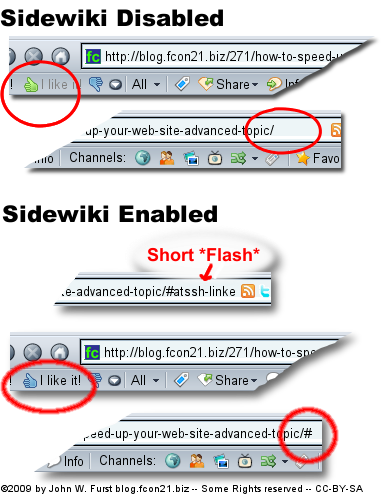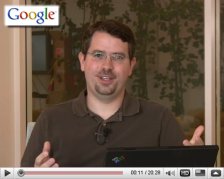After my post
Is Google Sidewiki Evil? I simply ignored the subject altogether and had disabled this function in my Google toolbar.
Yesterday, I noticed two very good posts with additional insights, good user comments, and I also added my
mustard (as Germans would say) to the conversation and to the Google Help Forum as well.
But first things first.
Not many people are talking about this:
Google Sidewiki API
At least there is a documented API. All details about the
Google Sidewiki API (↑) on Google's site. Here is what a developer can do with it.
→ Continue reading:
Do you have Google Toolbar With Sidewiki installed?
If yes, please, watch the navigation bar of your browser.
I am using Firefox and noticed a hashtag after the URL in many instances. Not always, so I am not sure about a pattern, yet. When I turn Sidewiki off in the toolbar this effect disappears. Here is the proof.
Google Toolbar Seems To Interfere With Other Browser Add-ons
→ Continue reading:
A couple of thoughts about Google's new sidewiki.
There are already a lot of webmasters, advertising professionals, and business owners who are asking — actually demanding — an opt-out mechanism to block sidewiki from your site.
Now, Google points out two things:
- A webmaster can claim the first spot, the first comment that is shown on a page.
- They will algorithmically solve abuse problems.
- But you cannot opt-out.
Okay,let's see.
I follow the example which Google gives in their help pages and check their own webmaster's entry on their toolbar blog.
→ Continue reading:
This shall be a very quick update and summary with my final SEO advice for some time. It seems that my
chronological report about the evolution of SEO configuration on this blog confused many readers.
I apologize and make it good with this post.
It was not so much the fact that most of you live and breath in a
Wordpress world. It was more about my deep dive into the abyss of Apache's URL redirection, .htaccess configuration, and the ever changing schemes of URLs used here on this blog. That's where I lost many of you.
It's too easy to get carried away while being intensively involved with fixing a problem.
Yesterday I already have emailed a short summary with
Top 10 SEO Tips for Blogs (↑) to my newsletter subscribers. It lists the major points and adds you should make use of sitemaps and Google's free webmaster tools.
Now, in order to conclude this short, unplanned series of articles about SEO I have for you:
- A 20 minute long video presentation of Google's Matt Cutts talking about duplicate content and how to use the new canonical URL parameters properly.
- Plugins for
- Wordpress and
- Serendipity S9Y weblog software.
- And I also found a comprehensive SEO guide for Wordpress users.
Let me start introducing the video with a catchy quote.
- We reserve the right to do what we think is best.
--Matt Cutts, Google.com
→ Continue reading:
I implemented a couple of SEO related (search engine optimization) changes on this blog. But I did not stop there. I introduced some new features for my readers as well.
As a result and the side-effect of it, the 10 or 15 latest blog posts have been re-published on the RSS feed with ever slightly changing URLs. I had the RSS feed turned off today to minimize the effect this had on Feedburner, and your RSS blog subscriptions.
I hope you can forgive me that
faux pax. I wrote about those side-effects in the original article where I go in detail over the
background for the SEO changes.
The main SEO changes revisited
→ Continue reading:
I must admit when I first setup my E-biz Booster Blog I did not know much about search engine optimization (SEO).
Finally I have changed and improved my permalink structure. It is not only more SEO friendly but in fact has increased usability, too. Whenever you change URLs it should be your goal to redirect your old URLs to the new ones because you
- cannot change all links to your site that exists out on the Web
- don't really want to spend the time to change internal links manually.
It is best to make sure the old and the new link structures work in parallel. That's exactly what I have done. Luckily Google has introduced a new feature in March 2009 that made that change more easy for me. You can read about that in a minute.
Bottom line, you don't have to be a
SEO specialist from Stompernet.
However, let me start with the full story
→ Continue reading:






